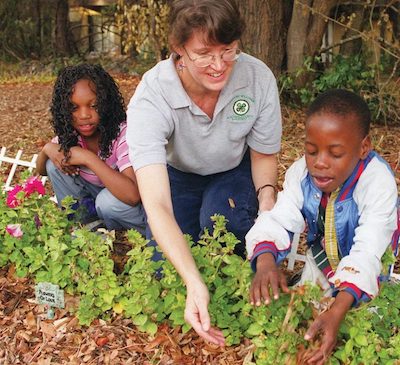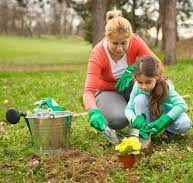Introduce a Child to Gardening
By Terri McClain, Fairfax Master Gardener Intern
 If there’s a child in your life — a grandchild, niece, nephew, a friend’s child, a neighbor or your own son or daughter — there’s a wonderful gift that you can offer them. Take them outside and share your love of gardening with them! As recently as one generation ago, more families in this country kept a garden, whether it was for vegetables or flowers. That has changed, and today fewer children than ever experience gardening.
If there’s a child in your life — a grandchild, niece, nephew, a friend’s child, a neighbor or your own son or daughter — there’s a wonderful gift that you can offer them. Take them outside and share your love of gardening with them! As recently as one generation ago, more families in this country kept a garden, whether it was for vegetables or flowers. That has changed, and today fewer children than ever experience gardening.
Children today spend less time outdoors
It is common to hear parents of small children speak nostalgically about spending many hours outside during their own childhoods when they say, “We played outside from morning ‘til the streetlights came on” or “We only had to go home for dinnertime.” Very few American children today are spending that much time outside. In fact, most children in this country hardly play outside or in natural environments on a regular basis at all. Parents today are nervous about their children staying outside unsupervised. More children regularly spend hours each day on electronic devices. Thanks to overdevelopment, not all children live near a natural environment that they could explore, even if they wanted to do so.
Why it’s important to spend time outdoors
Any gardener knows about the mental health benefits of being outdoors. Many gardeners are at their happiest while working in the garden. But it’s not just about feeling happy. Research around the world has shown that being outdoors even for short periods can lower stress levels and blood pressure, raise levels of Vitamin D, improve nighttime sleep habits, improve healing and boost immunity. Outside activity also can reduce the risk of anxiety and depression, lessen symptoms of ADHD, boost creativity, improve memory and more. There are additional benefits for children: reduced likelihood of myopia (near-sightedness), a boost in brain development, fewer behavioral issues and increased academic performance. This is not to mention an increase in exercise. Working in a garden also gives opportunities for children to learn about different topics.
 In addition to all these mental, cognitive and physical health benefits, working in a garden outside not only helps a child connect with nature, but also to connect with people. How many times have you asked an avid gardener how they got started and heard, “My grandfather was a gardener” or “I grew up gardening with my mother.”? An interest in gardening frequently begins in childhood when a child spends quality time in the garden with a loving adult, resulting in a life-long love of gardening.
In addition to all these mental, cognitive and physical health benefits, working in a garden outside not only helps a child connect with nature, but also to connect with people. How many times have you asked an avid gardener how they got started and heard, “My grandfather was a gardener” or “I grew up gardening with my mother.”? An interest in gardening frequently begins in childhood when a child spends quality time in the garden with a loving adult, resulting in a life-long love of gardening.
How to get kids outside
The main reason kids would want to be outside is the same reason we ourselves like to garden: it’s enjoyable. Children sense our enthusiasm and will more likely react positively to something when we are positive. Do you love vegetable gardening? Carve out a section of your vegetable bed and let a child choose what to plant. Help them take care of it and then harvest it together. This has the added benefit of introducing them to new foods. Do you like flowers? Have your child help select flowers from a catalog or seed packets and put them in charge of taking care of what they plant. Do you want to plant natives? A pollinator garden might attract children as well as pollinators. Does your child have an interest in wildlife? Set up a wildlife habitat and watch who comes to visit. When a garden has accessories that make it a nice place to hang out, kids may spend even more time there. Consider putting in stone or mulch pathways that lead to a bench, pergola, gazebo, arbor, chairs and table, sundial or bird bath. Container gardening or making a terrarium are options for a family without access to a garden plot. Other activities related to the garden can also be fun and educational, such as doing arts and crafts projects using leaves and flowers, drawing or painting plants, studying garden soil, collecting and researching insects or keeping a gardening journal.
And finally, don’t forget to keep it safe by making sure your child stays hydrated, wears sunscreen and/or a hat, wears weather-appropriate clothing, knows how to safely use tools and knows about any poisonous plants or venomous insects/animals they may come across in your gardening area.
If you know a child, please consider passing on your love of gardening to him or her. The idea is to make it a rewarding experience for children so they want to come back for more.
Resources
• Last Child in the Woods: Saving our Children from Nature-Deficit Disorder, by Richard Louv
• A Little Bit of Dirt: 55+ Science and Art Activities to Reconnect Children with Nature, by Asia Citro
• The Children’s Kitchen Garden: A Book of Gardening, Cooking, and Learning, by Georgeanne and
Ethel Brennan
• Kids’ Container Gardening: Year-round Projects for Inside and Out, by Cindy Krezel
• Vitamin N: 500 Ways to Enrich the Health and Happiness of Your Family and Community, by
Richard Louv
• 13 Remarkable Health Benefits of Getting Outdoors, Julie Singh, Trip Outside
• A prescription for better health: Go Alfresco, Harvard Health Publishing, Harvard Medical School
• Spending Time in Nature for Your Health, How Outdoor Activities Improve Wellbeing, South
University, Savannah, GA